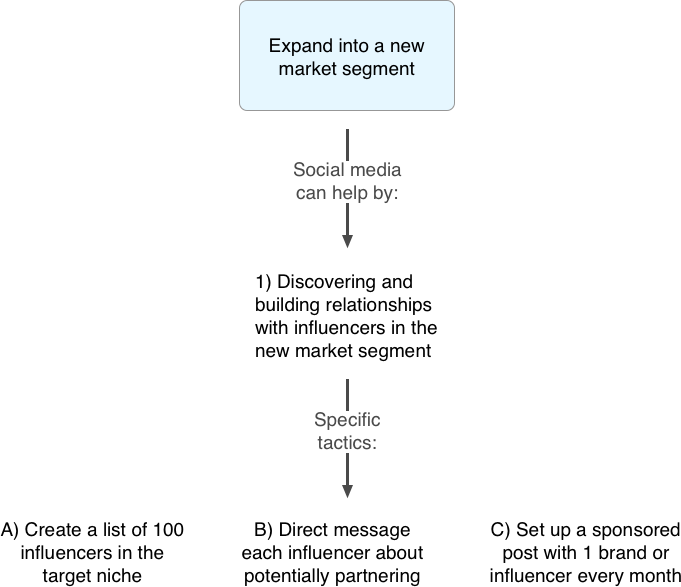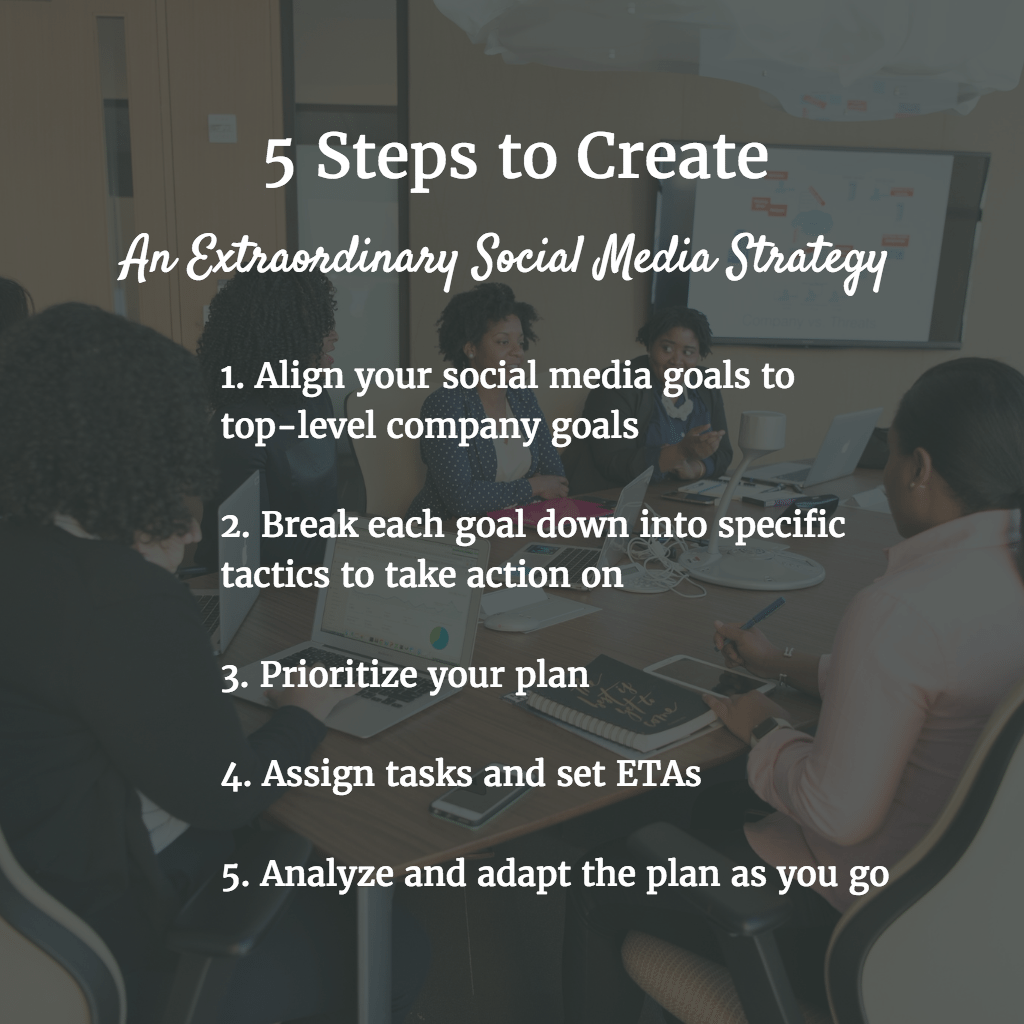
How to Break Down Your Social Media Goals Into Tactics and Plans
Crafting an effective social media strategy to help you achieve your goals can be a real challenge.
Like we mentioned before in a post about goal-setting strategies, coming up with social media goals for our marketing team here at Buffer has often been a bit haphazard for us.
There are so many goals we could potentially focus on – like brand awareness, engagement, traffic, and signups, to name a few. There’s also the challenge of figuring out how to make sure your social media goals are aligned with your overall company goals.
So how do we decide what to set our sights on for the coming year?
In this post, I’d love to share a framework you can use to make sure your social media marketing efforts are heading in the right direction and having the biggest impact this year (inspired by our friends at Moz).
And we’re always looking to find new ways to improve our goal-setting process. So feel free to share any thoughts and ideas you might have about how you might create a social media plan.
Let’s get started!

From social media goals to actionable tactics and plans
Step 1: Set social media goals that align with your overall company goals
If we want our social media marketing efforts to have the biggest impact, it’s super important that they’re aligned with our overall company goals and values.
If we’re all rowing in different directions, it’s really difficult to make any meaningful progress toward where we want to go.
“Not finance. Not strategy. Not technology. It is teamwork that remains the ultimate competitive advantage…
If you could get all the people in an organization rowing in the same direction, you could dominate any industry, in any market, against any competition, at any time.”
—Patrick Lencioni, best-selling author
With that in mind, as you’re setting your social media goals it’s important to zoom out and look at the big picture: how can social media impact your whole business, rather than just social media goals?
Then map your company’s top-level goals to how your social media efforts can best assist. Here’s an example to get a sense of what that could look like in practice…
Example: Setting goals for Campfire, Inc.
Imagine we run social media for a (fictional) company called Campfire, Inc.
Campfire’s top three company goals for 2017 are to:
- Expand into a new market segment
- Ship 3 new key product features
- Improve NPS score with their SMB customers

The key here is to take the goals that the founders, executives, or board care most about accomplishing, and show that social media can help achieve them in a meaningful way.
So, how can social media help us accomplish our company goals?
In order to help Campfire expand into a new market segment, we could:
- Discover and build relationships with influencers who can amplify our message within the new target market
- Partner with influencers and brands to leverage and grow our audience within the new target market
- Create and promote branded content that drives top-of-the-funnel growth in the new market and positions our company as a premier option
And to support the company’s initiative to ship 3 new key product features, we could:
- Run social media campaigns to promote product launches
- Raise awareness around and drive engagement of new features

Essentially, what this process is doing is taking the goals that are most important to your organization and aligning your social media goals to show that you’re helping to accomplish them.
So instead of saying, “we’re focusing on an influencer outreach strategy this quarter.” You could say, “In order to help us [accomplish our top-level company goal], we’re building an influencer outreach strategy.”
What if your company doesn’t have top-level goals that you can directly impact with social media?
In the absence of clear-cut company goals to connect your social media goals to, connect them with your marketing goals instead.
For example, here are a few ideas for social media goals and metrics you could focus on that would likely be aligned with your marketing efforts:
- Increase brand awareness — Follower count for your social profiles, reach of your social media posts, mentions, shares, and retweets
- Drive traffic to your website — Referral traffic from social media, share of overall traffic, bounce rate of social media traffic, and clicks on your social media posts
- Generate new leads — New leads collected through social media, downloads of your gated content, clicks on your lead-gen social media posts, and conversion rate of leads from social media
- Grow revenue — Signups, sales revenue, or revenue from social ads
- Boost brand engagement — Likes, shares, comments per post, mentions, and replies
- Build a community around your business — Number of posts, likes, and comments for Facebook groups. Number of participants and tweets per participant for Twitter chats. Number of daily active users for Slack communities
- Increase mentions in the press — Potential reach, shares and mentions, influencers talking about your content, and number of people reaching out to ask about industry-related questions
- Research and learn about your customers — Number of conversations with customers on social media, suggestions or feedback, and product/content improvements made from those suggestions

And if you want to learn how to track the goals in the example above, as well as the best tools to use, check out our guide on the types of social media goals you can set.

Step 2: Break down your goals into specific tactics
Once you’ve translated your company goals into social media goals, the next step is to map out the specific actions you need to take to accomplish the goals you’ve set.
Let’s jump back into our example from the previous step.
If our company goal at Campfire is to expand into a new market segment, and we’ve set a social media goal to discover and build relationships with influencers and brands in that market – how can we break that down into specific tactics we can take action on?
Here’s one way we could potentially approach it:
- Create a list of 100 influencers in the target niche who might be open to sponsored posts
- Direct message each of them to see if they’d be interested in partnering with us
- Set up a sponsored post with 1 brand or influencer every month
Now we can directly see how social media can influence the overall company goals:

The specific tactics you’ll use will be different depending on your goals, customers, market, product, and a number of other variables.
And you can adjust your plan over time as you start getting feedback and seeing the results of your tactics. We’ll talk more about that soon ?

Step 3: Prioritize your plan
Every marketing team, no matter its size, has finite resources. So it’s essential to prioritize your tactics and create a social media marketing plan from them.
How do you choose what to prioritize?
One approach I’ve found super useful and intuitive is ProductPlan’s value vs. complexity model. Here’s how it works:
- Evaluate how much value I expect each tactic will bring to the business
- Compare that to how much effort each tactic will likely require and how complex it will be to implement
- Prioritize the highest value tactics that require the least effort/complexity
There’s no way to predict exactly how much time and effort each tactic will take or how much value they’ll bring to the business! So do your best to make an educated guess and try not to get too hung up on perfection here.
You can be wrong about this. It’s okay to be, “Hey, we’re taking our best guess, thumb in the air. We don’t really know for sure, but we’re going to try.”
—Rand Fishkin, founder of Moz
Evaluating value vs. complexity
So looking at the graph below, the social media tactics that fall into section 1 of the model (high value, low complexity) would be our top priorities to tackle first.
The tactics that fall into section 2 (high value, high complexity) would be next on our list if we have the resources. And the rest of the tactics that fall into the other two sections probably aren’t worth focusing too much of our attention on – if any.

Here’s how ProductPlan’s founder, Jim Semick, describes this approach to prioritization:
In the Value versus Complexity model you evaluate every opportunity based on its business value and its relative complexity to implement.
The matrix is simple: The initiatives that have the highest value and the lowest effort will be the low-hanging fruit.
—Jim Semick

Step 4: Assign tasks and set ETAs
Once you’ve prioritized the specific tactics you plan on using to accomplish your social media goals, the next step is to add two elements to each tactic:
- Assign people – Who will work on and be responsible for each of them?
- Set an ETA – When would you like each of them to be to completed by?
Going back to our previous example with Campfire Inc, here’s what that might look like in action:
- Reach out to 100 influencers by Feb 1st [Assigned to: Brian]
- Direct message 100 influencers by Feb 20th [Assigned to: Brian]
- Set up 1 sponsored post by the 30th of each month [Assigned to: Brian, Hailley]


Step 5: Analyze and adapt the plan as you go
Last but not least, after you’ve set your plan it’s super important to make adjustments and adapt your goals and tactics as you go.
At least that’s how we tend to handle goal-setting on our marketing team here at Buffer – if something doesn’t feel right, we can always change it to something that’s a better fit.
Our marketing director Kevan summed it up well when he said:
I like to think of this plan like a roadtrip. Start out by pointing yourself in the right direction, then choose the way you’re going to get there, check in regularly to make sure you’re on track, and have some fun along the way.
—Kevan Lee

Over to you!
How do you set your social media goals?
When we’re setting our social media goals, we always try to align them with our big company goals – because we’ve seen that getting everyone rowing in the same direction can be a huge advantage for us.

We’re always experimenting and looking for ways to improve our goal-setting process, and I’d love to hear how you set social media goals at your company!
Do you use a different process?
How do you ensure your social media efforts benefit the business?
I’d love to hear your thoughts and learn more from you in the comments below. And I’d be happy to answer any questions you might have about our process as well.
Try Buffer for free
180,000+ creators, small businesses, and marketers use Buffer to grow their audiences every month.
Related Articles

Learn the fundamentals and advanced principles of Instagram marketing — with examples, expert tips, and timely best practices.

The ins and outs of Instagram Stories, from getting started to advanced strategies that will make your stories stand out on Instagram.

More followers on Pinterest could mean a boost in subscribers, sign-ups, sales, brand awareness, and more. Here are 20 practical tips you can start using today.